Marketing Essentials: Analysis of Toyota's Marketing Strategies Report
VerifiedAdded on 2021/08/04
|9
|2188
|90
Report
AI Summary
This report, centered on marketing essentials, provides a comprehensive analysis of marketing principles and their application in a business context. The report begins with an introduction to marketing, outlining its significance in modern business organizations, consumer behavior, and the development of customer-driven market strategies. Task 1 delves into the core concepts of marketing, including its roles, responsibilities, and the elements of the marketing process, emphasizing the importance of understanding the relationship between marketing and the broader organizational context. It also examines the key elements of marketing functions, their interrelations, and their connections to other functional units within an organization. Task 2 focuses on Toyota, discussing its marketing mix strategies, including place/distribution, promotion, and pricing. It analyzes how Toyota uses these strategies to achieve its business objectives. Finally, Task 3 guides the reader through the process of designing and assessing a basic marketing plan for a company, incorporating pricing, promotional, and distribution strategies, to achieve business goals.
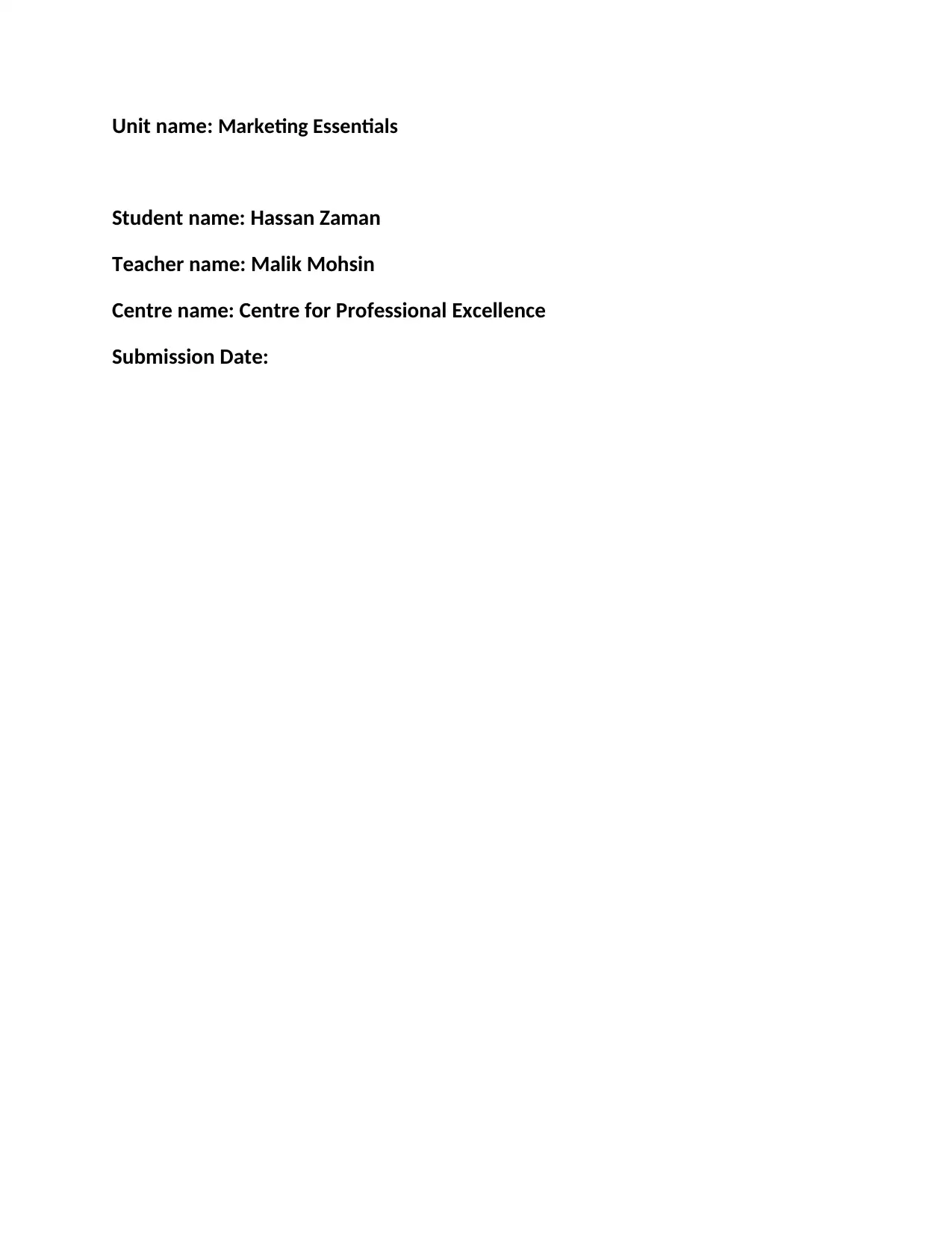
Unit name: Marketing Essentials
Student name: Hassan Zaman
Teacher name: Malik Mohsin
Centre name: Centre for Professional Excellence
Submission Date:
Student name: Hassan Zaman
Teacher name: Malik Mohsin
Centre name: Centre for Professional Excellence
Submission Date:
Paraphrase This Document
Need a fresh take? Get an instant paraphrase of this document with our AI Paraphraser
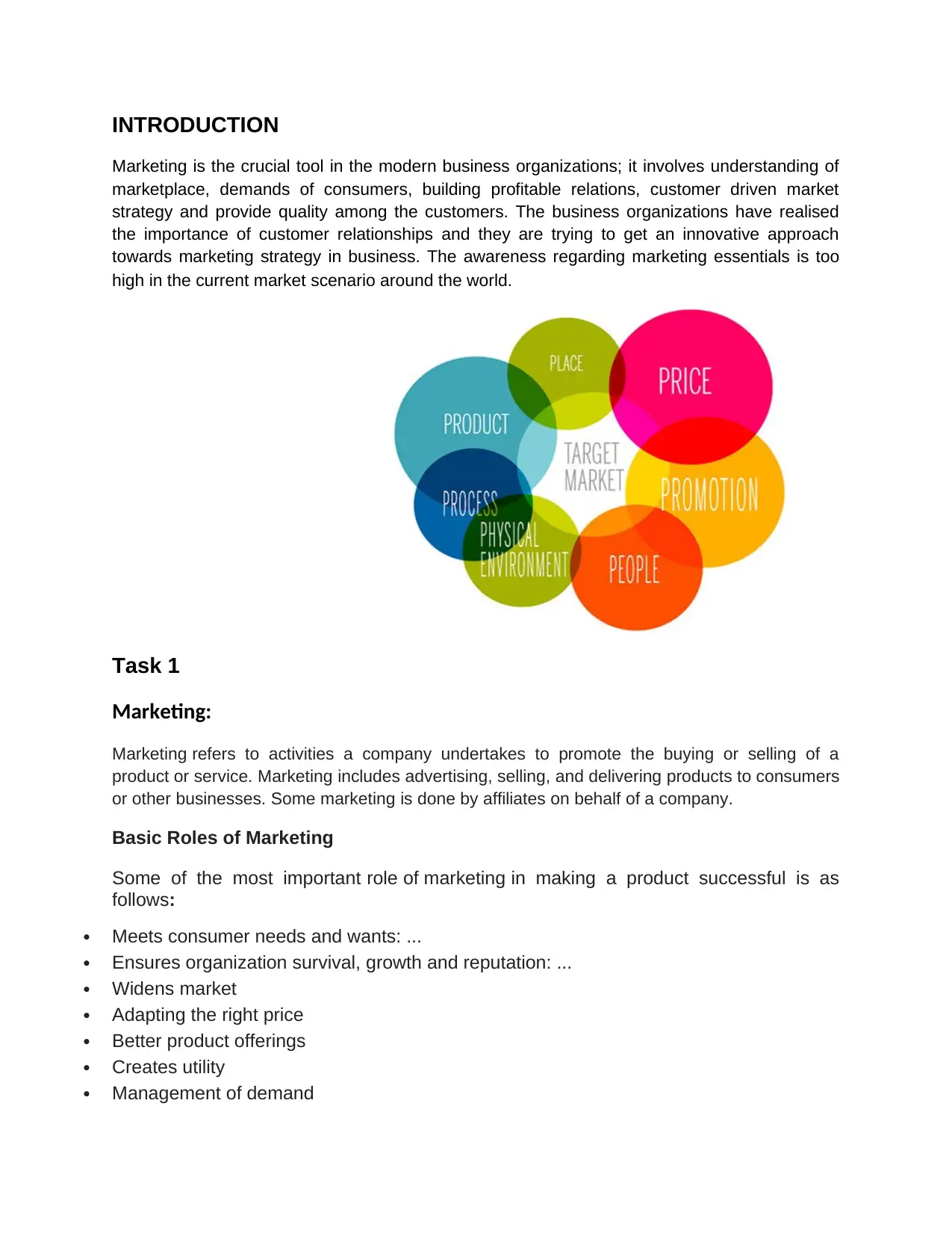
INTRODUCTION
Marketing is the crucial tool in the modern business organizations; it involves understanding of
marketplace, demands of consumers, building profitable relations, customer driven market
strategy and provide quality among the customers. The business organizations have realised
the importance of customer relationships and they are trying to get an innovative approach
towards marketing strategy in business. The awareness regarding marketing essentials is too
high in the current market scenario around the world.
Task 1
Marketing:
Marketing refers to activities a company undertakes to promote the buying or selling of a
product or service. Marketing includes advertising, selling, and delivering products to consumers
or other businesses. Some marketing is done by affiliates on behalf of a company.
Basic Roles of Marketing
Some of the most important role of marketing in making a product successful is as
follows:
Meets consumer needs and wants: ...
Ensures organization survival, growth and reputation: ...
Widens market
Adapting the right price
Better product offerings
Creates utility
Management of demand
Marketing is the crucial tool in the modern business organizations; it involves understanding of
marketplace, demands of consumers, building profitable relations, customer driven market
strategy and provide quality among the customers. The business organizations have realised
the importance of customer relationships and they are trying to get an innovative approach
towards marketing strategy in business. The awareness regarding marketing essentials is too
high in the current market scenario around the world.
Task 1
Marketing:
Marketing refers to activities a company undertakes to promote the buying or selling of a
product or service. Marketing includes advertising, selling, and delivering products to consumers
or other businesses. Some marketing is done by affiliates on behalf of a company.
Basic Roles of Marketing
Some of the most important role of marketing in making a product successful is as
follows:
Meets consumer needs and wants: ...
Ensures organization survival, growth and reputation: ...
Widens market
Adapting the right price
Better product offerings
Creates utility
Management of demand
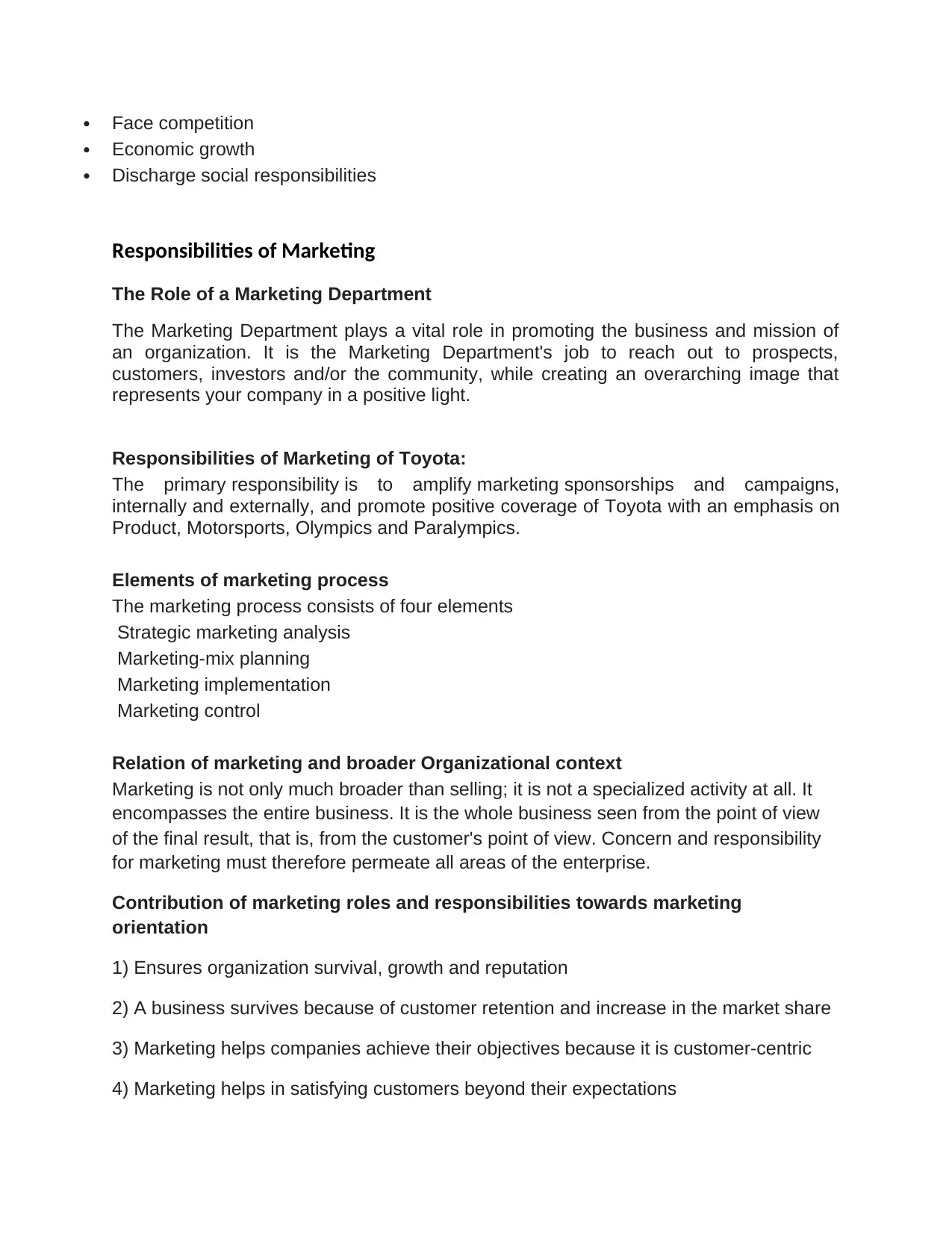
Face competition
Economic growth
Discharge social responsibilities
Responsibilities of Marketing
The Role of a Marketing Department
The Marketing Department plays a vital role in promoting the business and mission of
an organization. It is the Marketing Department's job to reach out to prospects,
customers, investors and/or the community, while creating an overarching image that
represents your company in a positive light.
Responsibilities of Marketing of Toyota:
The primary responsibility is to amplify marketing sponsorships and campaigns,
internally and externally, and promote positive coverage of Toyota with an emphasis on
Product, Motorsports, Olympics and Paralympics.
Elements of marketing process
The marketing process consists of four elements
Strategic marketing analysis
Marketing-mix planning
Marketing implementation
Marketing control
Relation of marketing and broader Organizational context
Marketing is not only much broader than selling; it is not a specialized activity at all. It
encompasses the entire business. It is the whole business seen from the point of view
of the final result, that is, from the customer's point of view. Concern and responsibility
for marketing must therefore permeate all areas of the enterprise.
Contribution of marketing roles and responsibilities towards marketing
orientation
1) Ensures organization survival, growth and reputation
2) A business survives because of customer retention and increase in the market share
3) Marketing helps companies achieve their objectives because it is customer-centric
4) Marketing helps in satisfying customers beyond their expectations
Economic growth
Discharge social responsibilities
Responsibilities of Marketing
The Role of a Marketing Department
The Marketing Department plays a vital role in promoting the business and mission of
an organization. It is the Marketing Department's job to reach out to prospects,
customers, investors and/or the community, while creating an overarching image that
represents your company in a positive light.
Responsibilities of Marketing of Toyota:
The primary responsibility is to amplify marketing sponsorships and campaigns,
internally and externally, and promote positive coverage of Toyota with an emphasis on
Product, Motorsports, Olympics and Paralympics.
Elements of marketing process
The marketing process consists of four elements
Strategic marketing analysis
Marketing-mix planning
Marketing implementation
Marketing control
Relation of marketing and broader Organizational context
Marketing is not only much broader than selling; it is not a specialized activity at all. It
encompasses the entire business. It is the whole business seen from the point of view
of the final result, that is, from the customer's point of view. Concern and responsibility
for marketing must therefore permeate all areas of the enterprise.
Contribution of marketing roles and responsibilities towards marketing
orientation
1) Ensures organization survival, growth and reputation
2) A business survives because of customer retention and increase in the market share
3) Marketing helps companies achieve their objectives because it is customer-centric
4) Marketing helps in satisfying customers beyond their expectations
⊘ This is a preview!⊘
Do you want full access?
Subscribe today to unlock all pages.

Trusted by 1+ million students worldwide
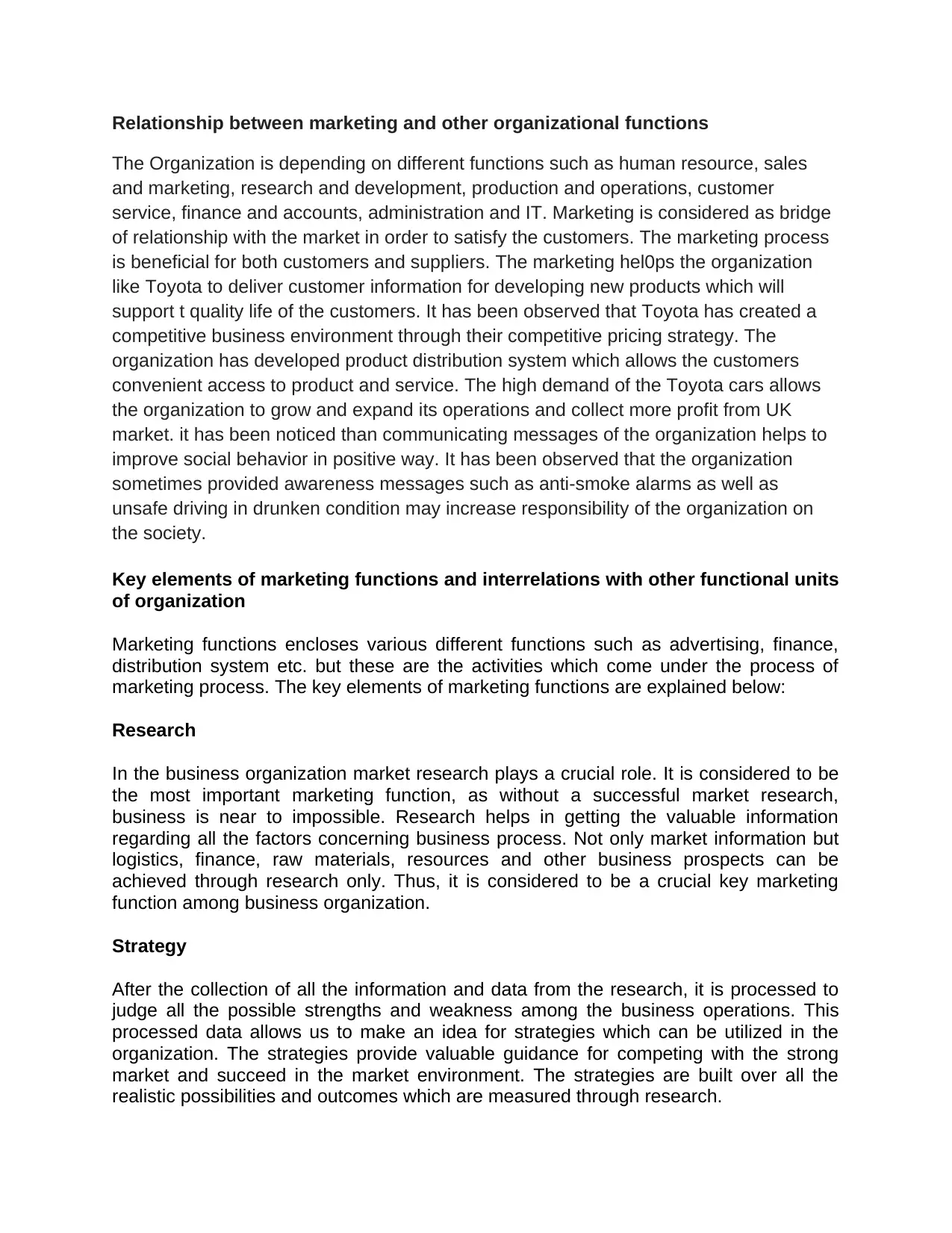
Relationship between marketing and other organizational functions
The Organization is depending on different functions such as human resource, sales
and marketing, research and development, production and operations, customer
service, finance and accounts, administration and IT. Marketing is considered as bridge
of relationship with the market in order to satisfy the customers. The marketing process
is beneficial for both customers and suppliers. The marketing hel0ps the organization
like Toyota to deliver customer information for developing new products which will
support t quality life of the customers. It has been observed that Toyota has created a
competitive business environment through their competitive pricing strategy. The
organization has developed product distribution system which allows the customers
convenient access to product and service. The high demand of the Toyota cars allows
the organization to grow and expand its operations and collect more profit from UK
market. it has been noticed than communicating messages of the organization helps to
improve social behavior in positive way. It has been observed that the organization
sometimes provided awareness messages such as anti-smoke alarms as well as
unsafe driving in drunken condition may increase responsibility of the organization on
the society.
Key elements of marketing functions and interrelations with other functional units
of organization
Marketing functions encloses various different functions such as advertising, finance,
distribution system etc. but these are the activities which come under the process of
marketing process. The key elements of marketing functions are explained below:
Research
In the business organization market research plays a crucial role. It is considered to be
the most important marketing function, as without a successful market research,
business is near to impossible. Research helps in getting the valuable information
regarding all the factors concerning business process. Not only market information but
logistics, finance, raw materials, resources and other business prospects can be
achieved through research only. Thus, it is considered to be a crucial key marketing
function among business organization.
Strategy
After the collection of all the information and data from the research, it is processed to
judge all the possible strengths and weakness among the business operations. This
processed data allows us to make an idea for strategies which can be utilized in the
organization. The strategies provide valuable guidance for competing with the strong
market and succeed in the market environment. The strategies are built over all the
realistic possibilities and outcomes which are measured through research.
The Organization is depending on different functions such as human resource, sales
and marketing, research and development, production and operations, customer
service, finance and accounts, administration and IT. Marketing is considered as bridge
of relationship with the market in order to satisfy the customers. The marketing process
is beneficial for both customers and suppliers. The marketing hel0ps the organization
like Toyota to deliver customer information for developing new products which will
support t quality life of the customers. It has been observed that Toyota has created a
competitive business environment through their competitive pricing strategy. The
organization has developed product distribution system which allows the customers
convenient access to product and service. The high demand of the Toyota cars allows
the organization to grow and expand its operations and collect more profit from UK
market. it has been noticed than communicating messages of the organization helps to
improve social behavior in positive way. It has been observed that the organization
sometimes provided awareness messages such as anti-smoke alarms as well as
unsafe driving in drunken condition may increase responsibility of the organization on
the society.
Key elements of marketing functions and interrelations with other functional units
of organization
Marketing functions encloses various different functions such as advertising, finance,
distribution system etc. but these are the activities which come under the process of
marketing process. The key elements of marketing functions are explained below:
Research
In the business organization market research plays a crucial role. It is considered to be
the most important marketing function, as without a successful market research,
business is near to impossible. Research helps in getting the valuable information
regarding all the factors concerning business process. Not only market information but
logistics, finance, raw materials, resources and other business prospects can be
achieved through research only. Thus, it is considered to be a crucial key marketing
function among business organization.
Strategy
After the collection of all the information and data from the research, it is processed to
judge all the possible strengths and weakness among the business operations. This
processed data allows us to make an idea for strategies which can be utilized in the
organization. The strategies provide valuable guidance for competing with the strong
market and succeed in the market environment. The strategies are built over all the
realistic possibilities and outcomes which are measured through research.
Paraphrase This Document
Need a fresh take? Get an instant paraphrase of this document with our AI Paraphraser
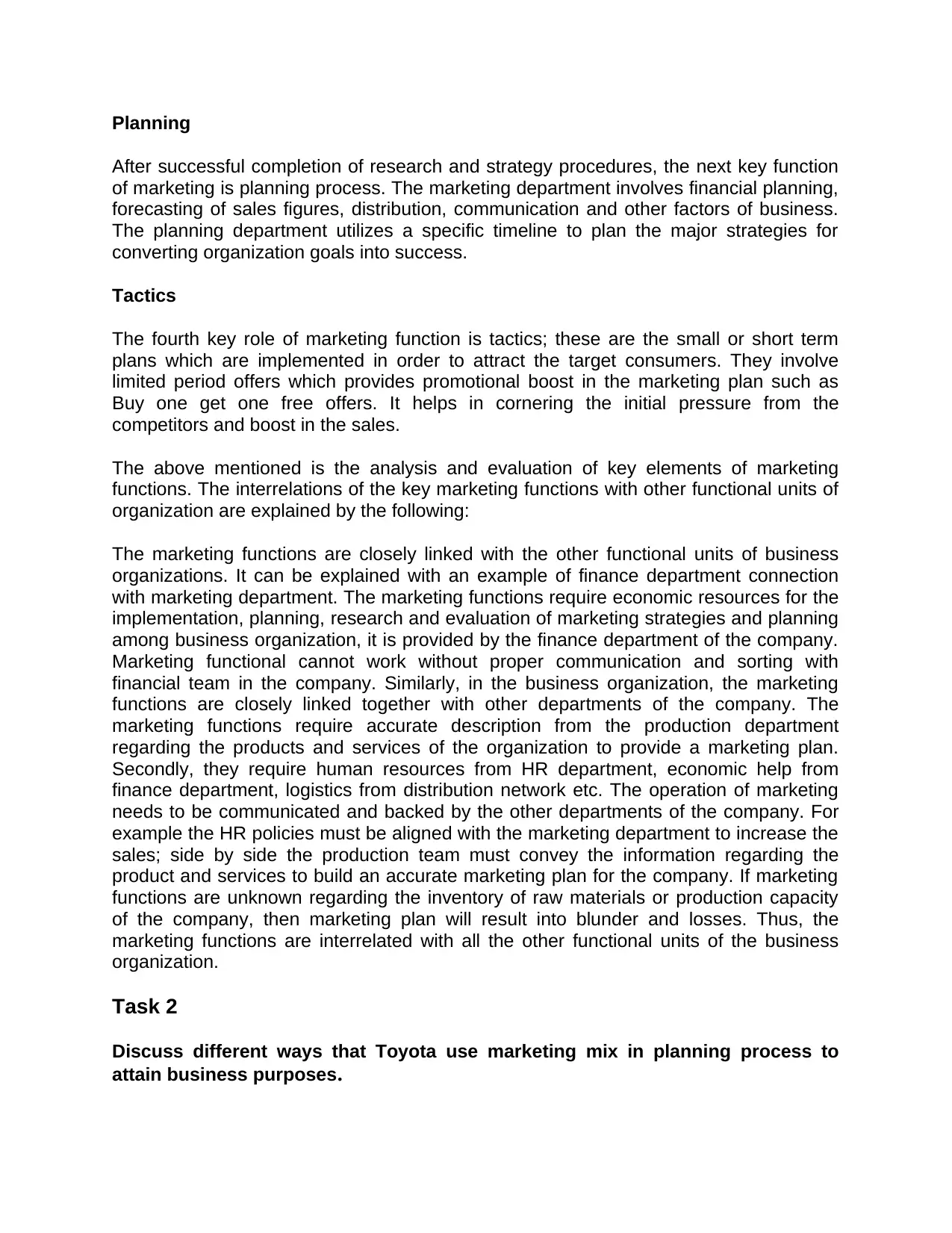
Planning
After successful completion of research and strategy procedures, the next key function
of marketing is planning process. The marketing department involves financial planning,
forecasting of sales figures, distribution, communication and other factors of business.
The planning department utilizes a specific timeline to plan the major strategies for
converting organization goals into success.
Tactics
The fourth key role of marketing function is tactics; these are the small or short term
plans which are implemented in order to attract the target consumers. They involve
limited period offers which provides promotional boost in the marketing plan such as
Buy one get one free offers. It helps in cornering the initial pressure from the
competitors and boost in the sales.
The above mentioned is the analysis and evaluation of key elements of marketing
functions. The interrelations of the key marketing functions with other functional units of
organization are explained by the following:
The marketing functions are closely linked with the other functional units of business
organizations. It can be explained with an example of finance department connection
with marketing department. The marketing functions require economic resources for the
implementation, planning, research and evaluation of marketing strategies and planning
among business organization, it is provided by the finance department of the company.
Marketing functional cannot work without proper communication and sorting with
financial team in the company. Similarly, in the business organization, the marketing
functions are closely linked together with other departments of the company. The
marketing functions require accurate description from the production department
regarding the products and services of the organization to provide a marketing plan.
Secondly, they require human resources from HR department, economic help from
finance department, logistics from distribution network etc. The operation of marketing
needs to be communicated and backed by the other departments of the company. For
example the HR policies must be aligned with the marketing department to increase the
sales; side by side the production team must convey the information regarding the
product and services to build an accurate marketing plan for the company. If marketing
functions are unknown regarding the inventory of raw materials or production capacity
of the company, then marketing plan will result into blunder and losses. Thus, the
marketing functions are interrelated with all the other functional units of the business
organization.
Task 2
Discuss different ways that Toyota use marketing mix in planning process to
attain business purposes.
After successful completion of research and strategy procedures, the next key function
of marketing is planning process. The marketing department involves financial planning,
forecasting of sales figures, distribution, communication and other factors of business.
The planning department utilizes a specific timeline to plan the major strategies for
converting organization goals into success.
Tactics
The fourth key role of marketing function is tactics; these are the small or short term
plans which are implemented in order to attract the target consumers. They involve
limited period offers which provides promotional boost in the marketing plan such as
Buy one get one free offers. It helps in cornering the initial pressure from the
competitors and boost in the sales.
The above mentioned is the analysis and evaluation of key elements of marketing
functions. The interrelations of the key marketing functions with other functional units of
organization are explained by the following:
The marketing functions are closely linked with the other functional units of business
organizations. It can be explained with an example of finance department connection
with marketing department. The marketing functions require economic resources for the
implementation, planning, research and evaluation of marketing strategies and planning
among business organization, it is provided by the finance department of the company.
Marketing functional cannot work without proper communication and sorting with
financial team in the company. Similarly, in the business organization, the marketing
functions are closely linked together with other departments of the company. The
marketing functions require accurate description from the production department
regarding the products and services of the organization to provide a marketing plan.
Secondly, they require human resources from HR department, economic help from
finance department, logistics from distribution network etc. The operation of marketing
needs to be communicated and backed by the other departments of the company. For
example the HR policies must be aligned with the marketing department to increase the
sales; side by side the production team must convey the information regarding the
product and services to build an accurate marketing plan for the company. If marketing
functions are unknown regarding the inventory of raw materials or production capacity
of the company, then marketing plan will result into blunder and losses. Thus, the
marketing functions are interrelated with all the other functional units of the business
organization.
Task 2
Discuss different ways that Toyota use marketing mix in planning process to
attain business purposes.
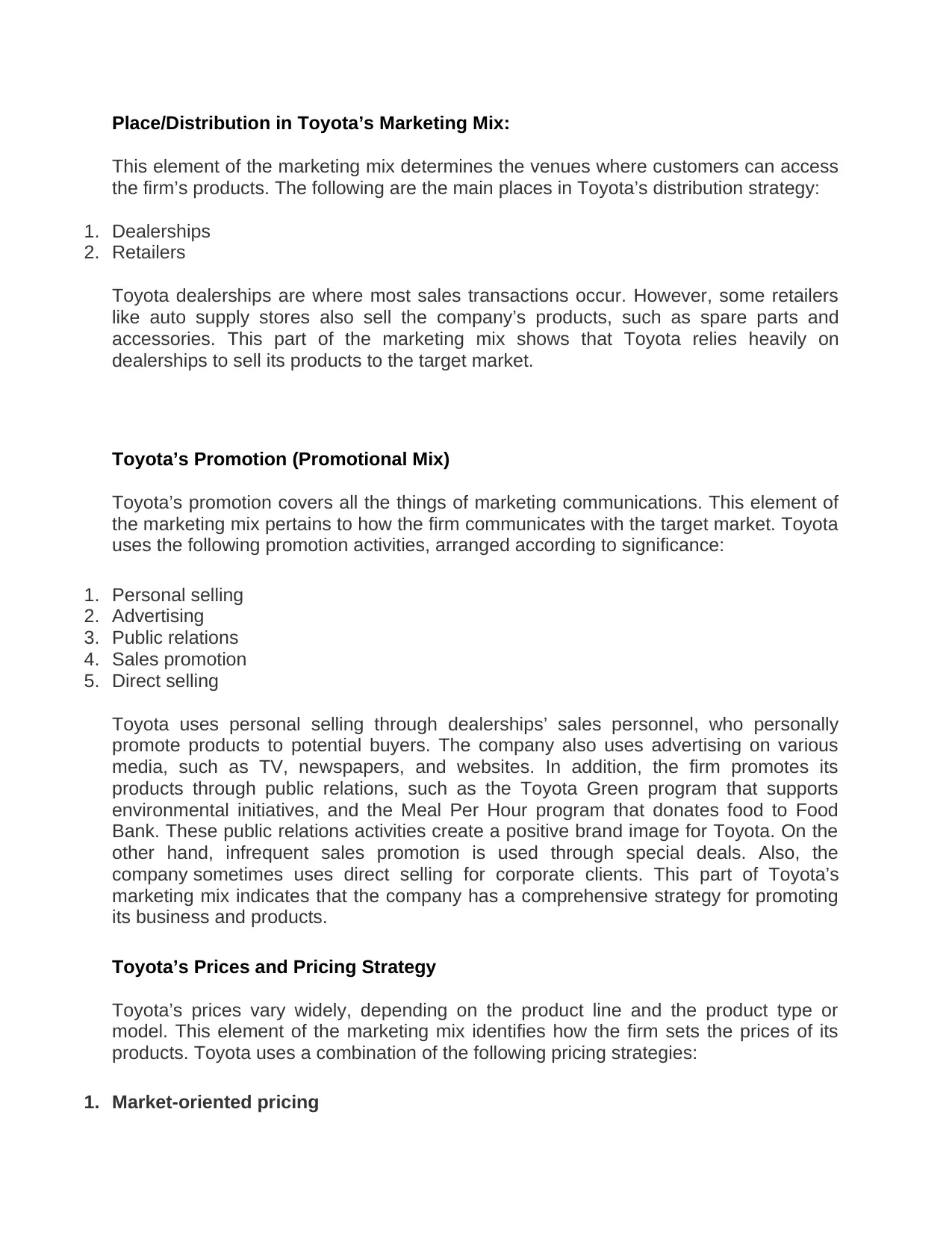
Place/Distribution in Toyota’s Marketing Mix:
This element of the marketing mix determines the venues where customers can access
the firm’s products. The following are the main places in Toyota’s distribution strategy:
1. Dealerships
2. Retailers
Toyota dealerships are where most sales transactions occur. However, some retailers
like auto supply stores also sell the company’s products, such as spare parts and
accessories. This part of the marketing mix shows that Toyota relies heavily on
dealerships to sell its products to the target market.
Toyota’s Promotion (Promotional Mix)
Toyota’s promotion covers all the things of marketing communications. This element of
the marketing mix pertains to how the firm communicates with the target market. Toyota
uses the following promotion activities, arranged according to significance:
1. Personal selling
2. Advertising
3. Public relations
4. Sales promotion
5. Direct selling
Toyota uses personal selling through dealerships’ sales personnel, who personally
promote products to potential buyers. The company also uses advertising on various
media, such as TV, newspapers, and websites. In addition, the firm promotes its
products through public relations, such as the Toyota Green program that supports
environmental initiatives, and the Meal Per Hour program that donates food to Food
Bank. These public relations activities create a positive brand image for Toyota. On the
other hand, infrequent sales promotion is used through special deals. Also, the
company sometimes uses direct selling for corporate clients. This part of Toyota’s
marketing mix indicates that the company has a comprehensive strategy for promoting
its business and products.
Toyota’s Prices and Pricing Strategy
Toyota’s prices vary widely, depending on the product line and the product type or
model. This element of the marketing mix identifies how the firm sets the prices of its
products. Toyota uses a combination of the following pricing strategies:
1. Market-oriented pricing
This element of the marketing mix determines the venues where customers can access
the firm’s products. The following are the main places in Toyota’s distribution strategy:
1. Dealerships
2. Retailers
Toyota dealerships are where most sales transactions occur. However, some retailers
like auto supply stores also sell the company’s products, such as spare parts and
accessories. This part of the marketing mix shows that Toyota relies heavily on
dealerships to sell its products to the target market.
Toyota’s Promotion (Promotional Mix)
Toyota’s promotion covers all the things of marketing communications. This element of
the marketing mix pertains to how the firm communicates with the target market. Toyota
uses the following promotion activities, arranged according to significance:
1. Personal selling
2. Advertising
3. Public relations
4. Sales promotion
5. Direct selling
Toyota uses personal selling through dealerships’ sales personnel, who personally
promote products to potential buyers. The company also uses advertising on various
media, such as TV, newspapers, and websites. In addition, the firm promotes its
products through public relations, such as the Toyota Green program that supports
environmental initiatives, and the Meal Per Hour program that donates food to Food
Bank. These public relations activities create a positive brand image for Toyota. On the
other hand, infrequent sales promotion is used through special deals. Also, the
company sometimes uses direct selling for corporate clients. This part of Toyota’s
marketing mix indicates that the company has a comprehensive strategy for promoting
its business and products.
Toyota’s Prices and Pricing Strategy
Toyota’s prices vary widely, depending on the product line and the product type or
model. This element of the marketing mix identifies how the firm sets the prices of its
products. Toyota uses a combination of the following pricing strategies:
1. Market-oriented pricing
⊘ This is a preview!⊘
Do you want full access?
Subscribe today to unlock all pages.

Trusted by 1+ million students worldwide
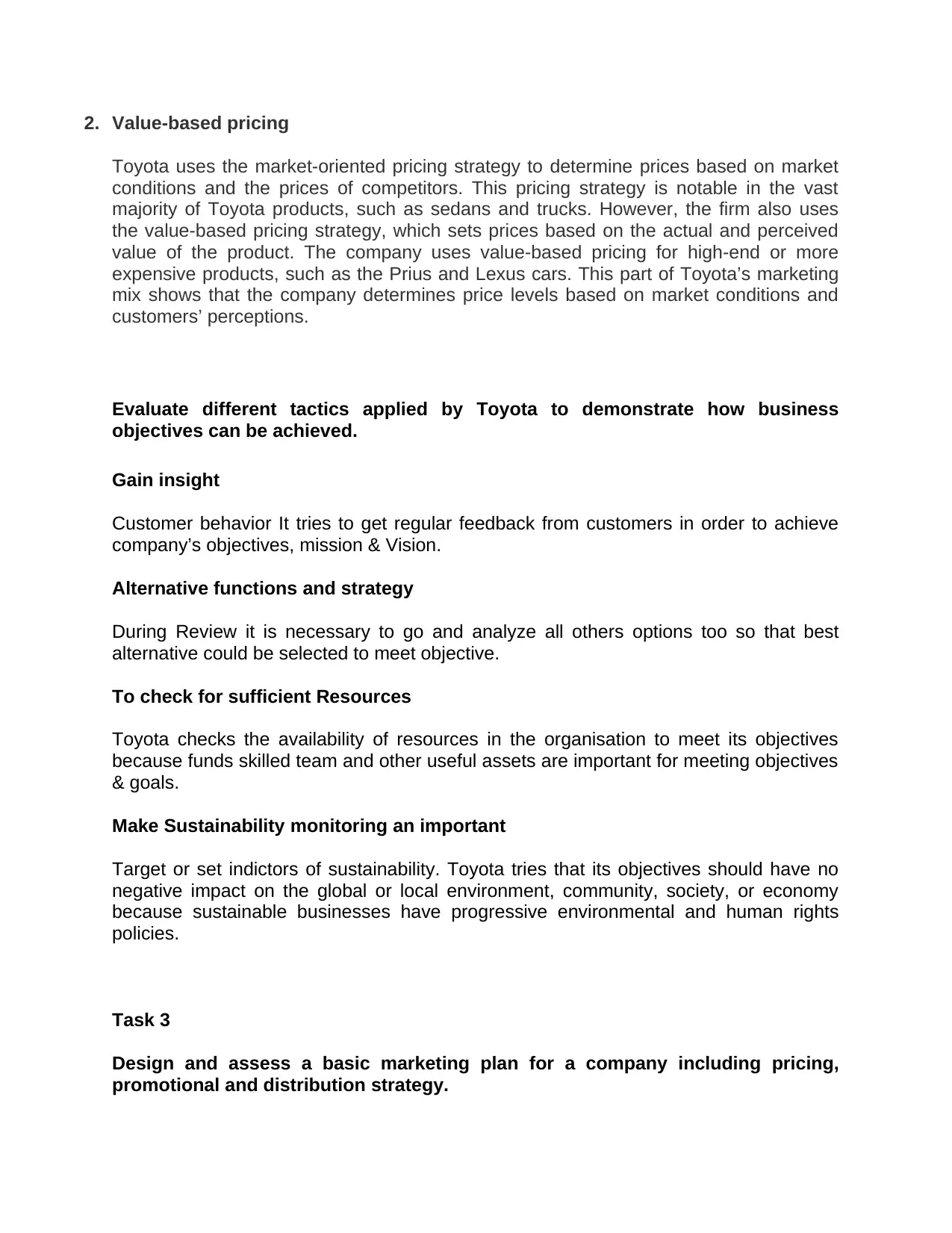
2. Value-based pricing
Toyota uses the market-oriented pricing strategy to determine prices based on market
conditions and the prices of competitors. This pricing strategy is notable in the vast
majority of Toyota products, such as sedans and trucks. However, the firm also uses
the value-based pricing strategy, which sets prices based on the actual and perceived
value of the product. The company uses value-based pricing for high-end or more
expensive products, such as the Prius and Lexus cars. This part of Toyota’s marketing
mix shows that the company determines price levels based on market conditions and
customers’ perceptions.
Evaluate different tactics applied by Toyota to demonstrate how business
objectives can be achieved.
Gain insight
Customer behavior It tries to get regular feedback from customers in order to achieve
company’s objectives, mission & Vision.
Alternative functions and strategy
During Review it is necessary to go and analyze all others options too so that best
alternative could be selected to meet objective.
To check for sufficient Resources
Toyota checks the availability of resources in the organisation to meet its objectives
because funds skilled team and other useful assets are important for meeting objectives
& goals.
Make Sustainability monitoring an important
Target or set indictors of sustainability. Toyota tries that its objectives should have no
negative impact on the global or local environment, community, society, or economy
because sustainable businesses have progressive environmental and human rights
policies.
Task 3
Design and assess a basic marketing plan for a company including pricing,
promotional and distribution strategy.
Toyota uses the market-oriented pricing strategy to determine prices based on market
conditions and the prices of competitors. This pricing strategy is notable in the vast
majority of Toyota products, such as sedans and trucks. However, the firm also uses
the value-based pricing strategy, which sets prices based on the actual and perceived
value of the product. The company uses value-based pricing for high-end or more
expensive products, such as the Prius and Lexus cars. This part of Toyota’s marketing
mix shows that the company determines price levels based on market conditions and
customers’ perceptions.
Evaluate different tactics applied by Toyota to demonstrate how business
objectives can be achieved.
Gain insight
Customer behavior It tries to get regular feedback from customers in order to achieve
company’s objectives, mission & Vision.
Alternative functions and strategy
During Review it is necessary to go and analyze all others options too so that best
alternative could be selected to meet objective.
To check for sufficient Resources
Toyota checks the availability of resources in the organisation to meet its objectives
because funds skilled team and other useful assets are important for meeting objectives
& goals.
Make Sustainability monitoring an important
Target or set indictors of sustainability. Toyota tries that its objectives should have no
negative impact on the global or local environment, community, society, or economy
because sustainable businesses have progressive environmental and human rights
policies.
Task 3
Design and assess a basic marketing plan for a company including pricing,
promotional and distribution strategy.
Paraphrase This Document
Need a fresh take? Get an instant paraphrase of this document with our AI Paraphraser
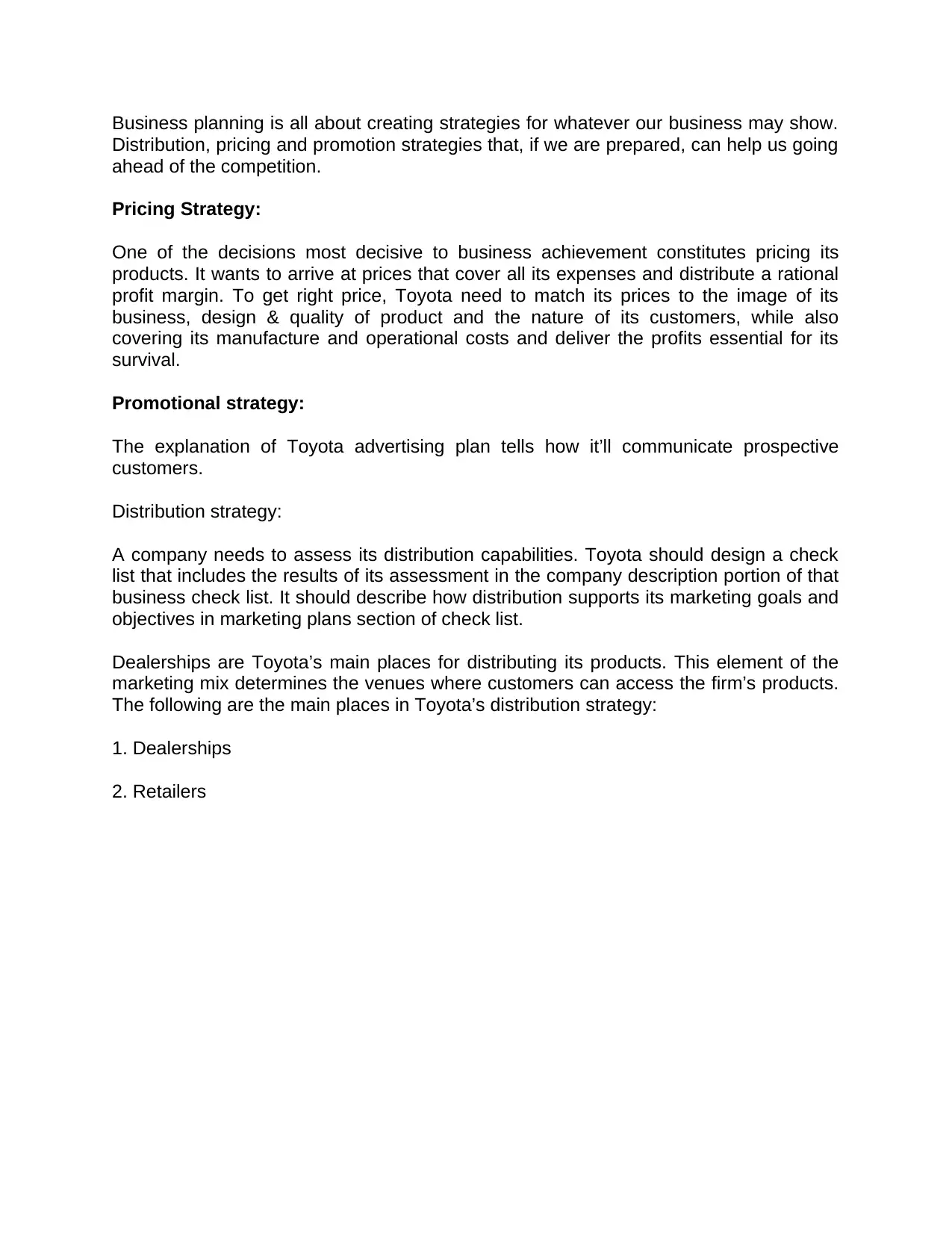
Business planning is all about creating strategies for whatever our business may show.
Distribution, pricing and promotion strategies that, if we are prepared, can help us going
ahead of the competition.
Pricing Strategy:
One of the decisions most decisive to business achievement constitutes pricing its
products. It wants to arrive at prices that cover all its expenses and distribute a rational
profit margin. To get right price, Toyota need to match its prices to the image of its
business, design & quality of product and the nature of its customers, while also
covering its manufacture and operational costs and deliver the profits essential for its
survival.
Promotional strategy:
The explanation of Toyota advertising plan tells how it’ll communicate prospective
customers.
Distribution strategy:
A company needs to assess its distribution capabilities. Toyota should design a check
list that includes the results of its assessment in the company description portion of that
business check list. It should describe how distribution supports its marketing goals and
objectives in marketing plans section of check list.
Dealerships are Toyota’s main places for distributing its products. This element of the
marketing mix determines the venues where customers can access the firm’s products.
The following are the main places in Toyota’s distribution strategy:
1. Dealerships
2. Retailers
Distribution, pricing and promotion strategies that, if we are prepared, can help us going
ahead of the competition.
Pricing Strategy:
One of the decisions most decisive to business achievement constitutes pricing its
products. It wants to arrive at prices that cover all its expenses and distribute a rational
profit margin. To get right price, Toyota need to match its prices to the image of its
business, design & quality of product and the nature of its customers, while also
covering its manufacture and operational costs and deliver the profits essential for its
survival.
Promotional strategy:
The explanation of Toyota advertising plan tells how it’ll communicate prospective
customers.
Distribution strategy:
A company needs to assess its distribution capabilities. Toyota should design a check
list that includes the results of its assessment in the company description portion of that
business check list. It should describe how distribution supports its marketing goals and
objectives in marketing plans section of check list.
Dealerships are Toyota’s main places for distributing its products. This element of the
marketing mix determines the venues where customers can access the firm’s products.
The following are the main places in Toyota’s distribution strategy:
1. Dealerships
2. Retailers

⊘ This is a preview!⊘
Do you want full access?
Subscribe today to unlock all pages.

Trusted by 1+ million students worldwide
1 out of 9
Related Documents
Your All-in-One AI-Powered Toolkit for Academic Success.
+13062052269
info@desklib.com
Available 24*7 on WhatsApp / Email
![[object Object]](/_next/static/media/star-bottom.7253800d.svg)
Unlock your academic potential
Copyright © 2020–2025 A2Z Services. All Rights Reserved. Developed and managed by ZUCOL.




